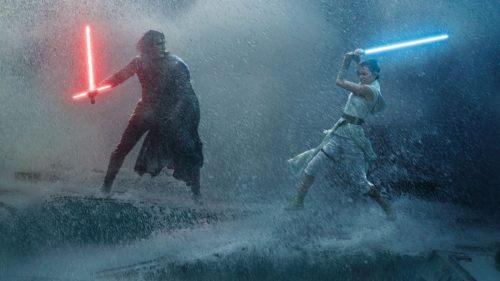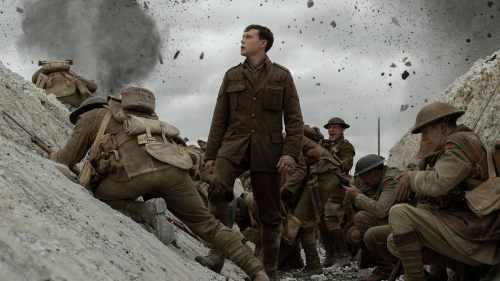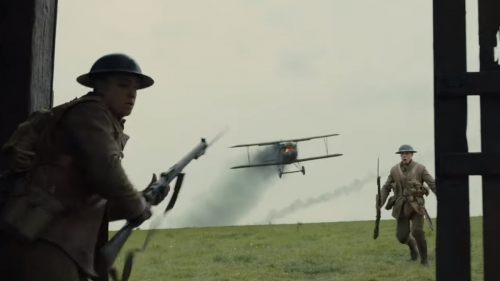Sam Mendes And Co. Talk 1917’s One-Shot Shenanigans
The First World War (or The Great War, if you’re of a certain age). It seems we have countless films about the conflict, from every possible angle. But we’ve never gotten a WWI film—or any war film—that was made to look like one continuous shot.
Sam Mendes and DP Roger Deakins recently pulled such a feat off with 1917, their new movie that was written, shot, and edited to appear as one continuous shot in real-time. At the New York Comic Con last week, the filmmakers behind 1917 held a panel to present the film’s one-shot conceit. Afterwards, I spoke with Mendes, Deakins, screenwriter Krysty Wilson-Cairns, producer Pippa Harris, and the film’s stars, George McKay and Dean-Charles Chapman. I got more insight about how this project came to be, and what it was like to actually make it.
“I had the idea of one person carrying a message and what if it took place in real-time. And then it became, ‘what if we never cut?’” Mendes said at the panel. “It was there from the beginning, written in the script. It was baked in, part of the fabric of the story. We didn’t take a structure and compose it on top of the script. When I went to Krysty with the story structure, I said ‘this is one shot and that’s what we have to write it for.’”
Mendes had screenwriter Krysty Wilson-Cairns write 1917 with the continuous shot in mind. Wilson-Cairns (who wrote for Penny Dreadful and is cowriting Edgar Wright’s upcoming Last Night in Soho) explained to me how this script was a welcome challenge. “This was different from any script I’ve ever written,” Wilson-Cairns said. “It was different in the sense that it’s cinematic in a way that I’ve never seen on a paper before. The proof of concept has never been considered in a lot of other scripts, so that was a bit mad.
“It’s different from Penny Dreadful in the sense that you’re trying to tell a very concise narrative over 150 minutes rather than a seasonal arc or story. But it draws on the same things. It’s there to entertain people. It’s there to thrill people. It’s there to keep you in your seat with ‘oh god what’s coming next?!’”
When I asked her if it was difficult to fit character arcs into 1917’s two-hour real-time story, Wilson-Cairns said, “Oh, yeah, it was so difficult to tell character arcs. Look at your own life: Was there a two-hour window in which you’re like ‘Yeah, it had a beginning middle, and end, it’d be satisfying for an audience to watch, and I’d spend 90 million making that into a movie?’ No! So it’s really hard to think, how you’re going to do that, and how you’re going to do that without pushing the realms of plausibility, because you want it to feel real and relevant. So you have to really consider how you’re going to do this story, and that’s a classic part of the one-shot.”
If you think the screenwriter had a rulebook to help her write 1917, think again. Wilson-Cairns told me about the difficulty of finding similar one-shot scripts to base her own off of. “It’s very difficult. There’s not a lot of them. There’s Victoria [the 2015 German one-shot film]. I watched that a lot in the sense of, ‘How do you tell a narrative in such a short space of time?’ And then I watched things like Birdman or even Goodfellas, where there’s a lot of tracking shots, to train my mind into thinking that way. But I couldn’t find a script for Victoria, and I couldn’t find a single script anywhere that was all in one shot. But now there is one, and hopefully it will be published so people can read it.”
Mendes was even prouder about 1917’s formal innovations. When I asked the director if he had any one-shot inspirations, he answered with, “Weirdly no, not one-shot movies. I was a huge fan of Birdman when it came out, and it was set in a world that’s very familiar to me, the world of Broadway theatre, and I loved it. But it’s quite different, you know. In a way, Birdman is primarily an interior movie, and it goes around and around in circles. You go in and out of the same locations, dressing rooms, corridors, and what have you.
“[1917] is quite different because it moves in a straight line. It’s a very linear movie, and it goes through landscape after landscape but it never goes back. And the landscape is constantly changing, so it’s only similar in the sense that it’s one shot. In every other respect, it’s a completely different kind of movie.”
That isn’t to say 1917 is devoid of influences. Mendes cited iconic war films “like Apocalypse Now and The Paths of Glory” The latter film, by Stanley Kubrick, famously used long-take dolly shots in its trench scenes, so in a way, 1917 can be thought of as an escalation of that.
Although 1917 is original in many ways, it isn’t the first time Mendes and DP Roger Deakins have worked together, nor is it the first time either have had to execute a complicated long-take with several moving pieces. Mendes said his experiences with the long takes in his Bond entries informed the way he approached 1917 greatly:
“Doing the opening sequence of Spectre gave me the confidence to do this movie, in a way, because I felt like, as long as you write into the story that you don’t need to cut, then you can carry on and do this for a whole movie. So it gave me that kind of courage to do that, because all of this is on such a huge scale, with thousands of extras, and it was very exhilarating doing it. If I hadn’t done the first sequence in Spectre, I’m not sure I would have had the balls to do this movie.”
Mendes might be underselling his ambition a bit, because to hear Deakins tell it, Sam had been hankering to shoot a continuous scene as far back as Skyfall’s elaborate casino sequence. “That was interesting because Sam was excited about that… He wanted very particularly to do the casino in one evolving shot,” Deakins recounted.
I asked Deakins about the differences between 1917 and his last war film Mendes-collaboration: Jarhead. When I told him how it’s one of my favorite movies, the legendary cinematographer perked up:
“Yeah, me too. I love that film,” Deakins said. “Jarhead was interesting because we started out saying, ‘Ok we have to shoot it all handheld, and we’re going to start shooting without rehearsing. I’ll just put the camera on my shoulder and we’ll just make it work. It was like I was doing a documentary… So you know, that was quite the antithesis of this film, which had to be meticulously worked out before we actually got to the set. It’s different, but that’s the fun of it.”
Pippa Harris, the co-founder of Mendes’ production company, was the producer of 1917, and she had no shortage of stories about the production challenges their team had to overcome. “It’s small things like how in a normal film, if you want to have a big wide open field at one location and then your next location is a canal, well obviously you can simply cut away to something else. We couldn’t do that, so we had to find a way of making these locations—which in many cases were hundreds of miles apart—feel as though they were geographically located together.
“Another thing that was very odd: when we were constructing the set, the trench runs that we built had to be the exact right length because if you didn’t have quite enough dialogue to get you to the end of the trench, you couldn’t simply cut and go to another scene because there isn’t another scene.”
There was one scene in particularly that Harris was amazed she and her team managed to pull off.
“There’s quite a big water sequence in the film with George [McKay] in a river. We needed to find a piece of river that we could control, and the reality is that you can’t control rivers. But we found a combination of part of the River Tees up in North of England and a white-water rafting center. We were able to combine them visually so they read as one location now, but the white water rafting center obviously was a much more controllable environment, and we were able to put George in without thinking ‘He’s gonna get swept away. We’re gonna lose him downstream.’”
When I asked George McKay about the river scene, he struggled to hide his grimace. (To be fair, he was probably trying hard to avoid spoilers.) “It was tough,” McKay said. “It was a point in the story that is hard. That’s the thing, that’s the beauty of doing the story the way that we did it. We did everything that these men go through, and it was tough.”
McKay’s co-star Dean-Charles Chapman described 1917 as “probably the most exhausting” project he’s worked on. “Takes would last up to eight minutes of us just crawling through no man’s land and running through the mud and bombs and getting shot at so… this was definitely the most exhausting thing I’ve done so far, emotionally and physically.”
Although, returning to my discussion with Roger Deakins, 1917’s continuous shot wasn’t about technical or athletic feats, or cool camera tricks (although those did play a factor). Deakins emphasized that the one-shot was the best tool for the story. “It’s a very particular story because it takes place in real-time. You’re only with these two characters, you’re not following other characters. I’d do it again, I love the experience, but it just depends on the project. I mean, I’ve done projects where I’ve hardly ever moved the camera and there’s hardly any cuts. Every project is different.
“There’s a fight in Skyfall in the glass building, and it’s all played in a silhouette profile before you figure out the camera is just slowly pushing in. It’s just a way of telling that part of the story. And this is a way of telling the whole story.”
1917 will have a limited release on December 25, 2019, before going wide January 20, 2020.



